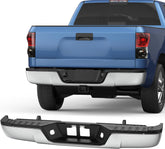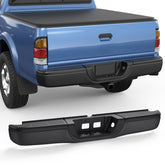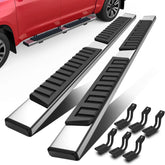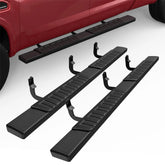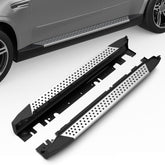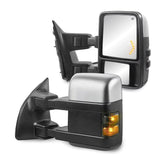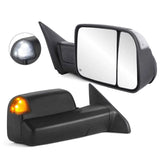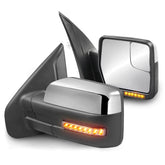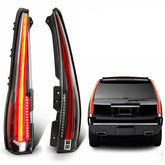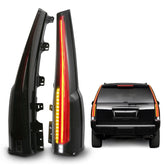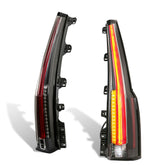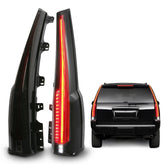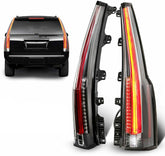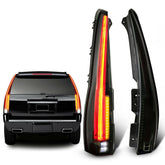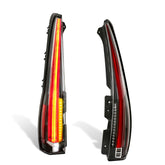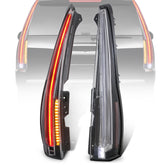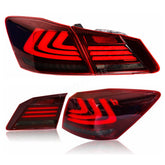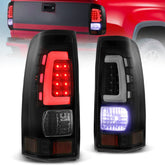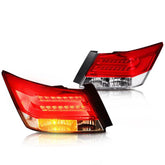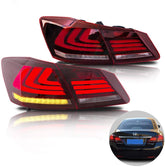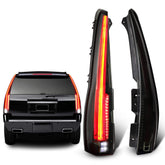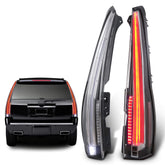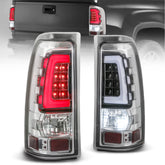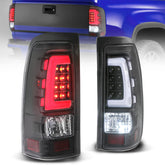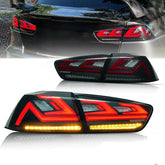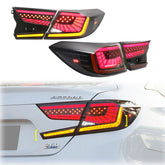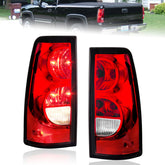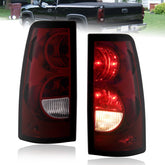Filter
43 results
20
- 10
- 15
- 20
- 25
- 30
- 50
Featured
- Featured
- Best selling
- Alphabetically, A-Z
- Alphabetically, Z-A
- Price, low to high
- Price, high to low
- Date, old to new
- Date, new to old
Sort
Sort by:
- Featured
- Best selling
- Alphabetically, A-Z
- Alphabetically, Z-A
- Price, low to high
- Price, high to low
- Date, old to new
- Date, new to old
-
Red Clear LED Tail Lights For 2007-2014 Cadillac Escalade ESV Rear Lamp Assembly with Red Turn LightVendor: MOSTPLUSSpecification: Brand: MOSTPLUS Warranty: 1 year Interchange Part Number: 22884388, 22884387, 22884390, 22884389 The Material of Base: ABS The Material of Mirror Cap: PMMA, Glass, etc. Including: 1 pair Tail Lights(Left side & Right side) Easy installation: Plug & Play, same as the original one...
- $409.99
$461.06- $409.99
- Unit price
- / per
-
For 2015-2020 GMC Yukon Smoke LED Tail Lights Rear Lamp Left+Right Cadillac StyleVendor: MOSTPLUSMOSTPLUS Smoke LED Tail Lights Rear Lamp Left+Right For 2015 2016 2017 2018 2019 2020 GMC Yukon (Cadillac Style) Specification: The Material of Base: ABS The Material of Mirror Cap: PMMA ,Glass, etc. Including: 1 pair Smock Tinted Tail Lights(Left side & Right side) Easy installation:Plug...
- $409.99
- $409.99
- Unit price
- / per
-
LED Tail Lights Rear Lamp For 2015-2020 GMC Yukon Cadillac Style Left+RightVendor: MOSTPLUSMOSTPLUS LED Tail Lights Rear Lamp For 2015 2016 2017 2018 2019 2020 GMC Yukon Cadillac Style Specification: The Material of Base: ABS The Material of Mirror Cap: PMMA ,Glass, etc. Including: 1 pair Smock Tinted Tail Lights(Left side & Right side) Easy installation:Plug &...
- $409.99
- $409.99
- Unit price
- / per
-
Smoked LED Tail Lights for 2015-2020 Chevrolet Chevy Tahoe Suburban Rear LampsVendor: MOSTPLUSDetails Housing Color: Black Lens Color: Smoke/Tinted Bulb Type: LED Bulbs Included: Yes Brand: MOSTPLUS Warranty: 1 Year Feature Easy installation: Plug&Play, same as original one to install (Note: the plug is behind bumper and not from the light. ) High quality: Approved by...
- $399.99
$473.04- $399.99
- Unit price
- / per
-
Red Clear LED Tail Lights for 2015-2020 Chevrolet Chevy Tahoe Suburban Rear Lamp BrakeVendor: MOSTPLUSMOSTPLUS LED Tail Lights Compatible with 2015 2016 2017 2018 2019 2020 Chevrolet Chevy Tahoe Suburban | Set of 2 (Red Clear) Details: Housing Color: Black Lens Color: Red Bulb Type: LED Bulbs Included: Yes The Material of Mirror Cap: PMMA, Glass, etc. Brand:...
- $399.99
$486.98- $399.99
- Unit price
- / per
-
Smoked LED Rear Lamp Tail Lights For 2007-2014 Chevy Suburban 1500 Tahoe GMC YukonVendor: MOSTPLUSMOSTPLUS LED Rear Lamp Tail Lights For 2007 2008 2009 2010 2011 2012 2013 2014 Chevy Suburban 1500 Tahoe GMC Yukon Specification Color: Smoke/Tinted ABS Material of Base The Material of Mirror Cap: PMMA ,Glass, etc. Plug & Play, Easy Installation Installation Guide 2...
- $409.99
$483.37- $409.99
- Unit price
- / per
-
LED Rear Tail Lights For 2007-2014 Chevy Suburban 1500 Tahoe GMC YukonVendor: MOSTPLUSMOSTPLUS LED Rear Tail Lights For 2007-2014 GMC Yukon ; 2007-2014 Chevrolet Tahoe ; 2007-2014 Chevrolet Suburban 1500 Specification ABS Material of Base The Material of Mirror Cap: PMMA ,Glass, etc. Includes 1 Pair LED Tail Light (left & right sides) Plug & Play, Easy Installation...
- $409.99
- $409.99
- Unit price
- / per
-
Transparent LED Tail Lights For 2007-2014 GMC Yukon Chevy Suburban Tahoe Rear LampsVendor: MOSTPLUSFeatures Brand: MOSTPLUS Warranty: 1 Year Interchange OEM #: 116226001, 116226009, 25841507, 25975975, 25841508, 25975976, 22837847, 22837848,2801267, 2800267, 2800204, 2801204 ABS Material of Base The Material of Mirror Cap: PMMA ,Glass, etc. Color of Lights: LED Light Bar/Lighting; Turning Singal : Yellow Brake light:...
- $409.99
- $409.99
- Unit price
- / per
-
Led Brake Tail Lights for 2013-2015 Honda Accord 4 door Sedan (Red Smoke )Vendor: MOSTPLUSDetails Housing Color: Black Lens Color: Red Bulb Type: LED Bulbs Included: Yes Brand:MOSTPLUS Warranty:1 Year Feature Easy installation: Plug&Play. same as original one to install; Color of Light: Running light & Brake light are Red; Sequential Turning signal Yellow; Reverse light : White...
- $208.89
- $208.89
- Unit price
- / per
-
Smoke Tinted LED Tail Lights For 1999-2006 Chevy Chevrolet Silverado 1500 2500/1999-2002 GMC Sierra 1500 2500 Rear Lamp (Fleetside Bed Models Only)Vendor: MOSTPLUSSPECIFICATIONS: Brand: MOSTPLUS Warranty: 1 year Housing Color: Black Lens Color: Smoke Tinted OE/OEM Part Number: GM2800186,GM2800174,GM2801186,GM2801174 Interchange Part Number: GM2800186,GM2800174,GM2801186,GM2801174, 19169004, 19169017, 19169018, 19169005, 19169018 Package Includes: 1 Pair Tail Light Assembly (left and right sides) with Black Housing and Smoke Tinted Lens Lens Material: PC...
- $139.99
- $139.99
- Unit price
- / per
-
LED Brake Tail Lights for Honda Accord 2008-2012 4 Door SedanVendor: MOSTPLUSDetails: Brand: MOSTPLUS Warranty: 1 Year Housing Color: Black Lens Color: Red Surface Finish: ABS Bulbs Included: Yes Lighting Technology: LED Fitment Type: Performance/Custom Placement on Vehicle: Rear, Left, Right Features: Brand New ABS Material Base The color is Red/Clear Easy installation: Plug &...
- $198.69
- $198.69
- Unit price
- / per
-
Red Clear LED Brake Tail Lights for 2013 2014 2015 Honda Accord 4 Door SedanVendor: MOSTPLUSTail lights are not only a necessity for a safe night-driving, but also a necessity to anyone wanting to add that custom look to their car or truck. MOSTPLUS gives your car or truck an awesome new appearance. Compared to other styling modifications, our...
- $212.99
$289.99- $212.99
- Unit price
- / per
-
Smoked Tinted LED Tail Lights for 2007-2014 Cadillac Escalade ESV Assembly Rear LampVendor: MOSTPLUSSpecification: The Material of Base: ABS The Material of the Mirror Cap: PMMA, Glass, etc. Easy installation: Plug & Play, same as the original one to install Interchange OEM #: 22884388, 22884387, 22884390, 22884389, 22865549, 2801232, 2800232, 166-00788R; Package Includes 1 Pair LED Tail...
- $409.99
- $409.99
- Unit price
- / per
-
Transparent LED Tail Lights For 2007-2014 Cadillac Escalade ESV Rear Lamp Assembly with Red Turn LightVendor: MOSTPLUSDetails: Brand: MOSTPLUS Warranty: 1 year Interchange Part Number: 22884388, 22884387, 22884390, 22884389 The Material of Base: ABS The Material of Mirror Cap: PMMA, Glass, etc. Turning Singal: Red Brake Lights: Red; Reverse Lights: White Running Lights: Red Light Cover: Transparent Led Light Strip: Transparent...
- $409.99
$410.52- $409.99
- Unit price
- / per
-
Transparent LED Tail Lights For 1999-2006 Chevy Silverado/1999-2002 GMC Sierra 1500/2500/3500 Rear Lamp (Fleetside Bed Models Only)Vendor: MOSTPLUSDetails: Brand: MOSTPLUS Warranty: 1 year Housing Color: Chrome (Crystal) OE/OEM Part Number: GM2800186,GM2800174,GM2801186,GM2801174 Interchange Part Number: GM2800186,GM2800174,GM2801186,GM2801174, 19169004, 19169017, 19169018, 19169005, 19169018 Placement on Vehicle: Left, Rear, Right Package Includes: 1 Pair Tail Light Assembly (left and right sides) with Chrome Housing and...
- $139.99
- $139.99
- Unit price
- / per
-
Clear LED Tail Lights Assembly For 1999-2006 Chevy Silverado GMC Sierra 1500 2500HD Rear Lamp (Fleetside Bed Models Only)Vendor: MOSTPLUSDetails: Brand: MOSTPLUS Warranty: 1 year Housing Color: Black Lens Color: Clear Interchange Part Number: GM2800186,GM2800174,GM2801186,GM2801174 Placement on Vehicle: Left, Rear, Right Package Includes: Driver & Passenger Side Material: ABS Plastic Housing / Polycarbonate Lens Features: Condition: 100% Brand New and High Quality Material: ABS Plastic...
- $139.99
- $139.99
- Unit price
- / per
-
Tail Lights For 2008-2017 Mitsubishi Lancer EX EVO X Sedan Rear LampsVendor: MOSTPLUSDetails: Brand: MOSTPLUS Warranty: 1 year Housing Color: Smoke Placement on Vehicle: Rear, Left, Right, Outer Interchange Part Number: 8330A107, 8330A108, 8330A111, 8330A4768330A625, 8330A626, 8330A621, 8330A622 Certifications: DOT Features: Condition:100% Brand New Bulbs: All bulbs are built-in, no extra bulbs are needed Function: Rear Trunk...
- $289.99
$299.99- $289.99
- Unit price
- / per
-
Smoked LED Rear Tail Light Rear Lamp Assembly For 2018-2020 Honda Accord One PairVendor: MOSTPLUSDetails: Brand: MOSTPLUS Warranty: 1 year Placement on Vehicle: Rear, Left, Right, Inner, Outer Lens Color: Smoke Voltage: 12V Fitment Type: Direct Replacement Material: ABS + High Quality LED Lifetime: over 50,000 hours Center Luminous Intensity >400CD Working temperature: -35°C to 45°C Luminous Flux: ≥480lm ...
- $249.99
- $249.99
- Unit price
- / per
-
Tail Lights Rear Lamps Red Lens For 2003-2006 Chevy Silverado 1500 2500 3500 HD 2pcsVendor: MOSTPLUSDetails: Brand: MOSTPLUS Warranty: 1 Year Type: Tail Light Lens Color: Red Housing Color: Chrome Housing with Red Lens Lighting Type: Trailer Lights Interchange Part Number: 19169005, 19169004 Other Part Number: GM2800174, GM2801174 Fitment Type: Direct Replacement Placement on Vehicle: Driver, Passenger, Left, Rear,...
- $83.99
- $83.99
- Unit price
- / per
-
Tail Lights Rear Lamp Smoke Lens For 2003-2006 Chevy Silverado 1500 2500 3500 2pcsVendor: MOSTPLUSDetails: Brand: MOSTPLUS Warranty: 1 Year Type: Taillight/Tail light/Tail lamp Color: Dark Red Lens Color: Smoke Material: ABS Plastic (Housing) / Polycarbonate (Lens) Voltage: 12 VDC Placement on Vehicle: Rear Left and Right Features: New and in a Good Condition Direct Fit Replacement OEM...
- $81.99
- $81.99
- Unit price
- / per
